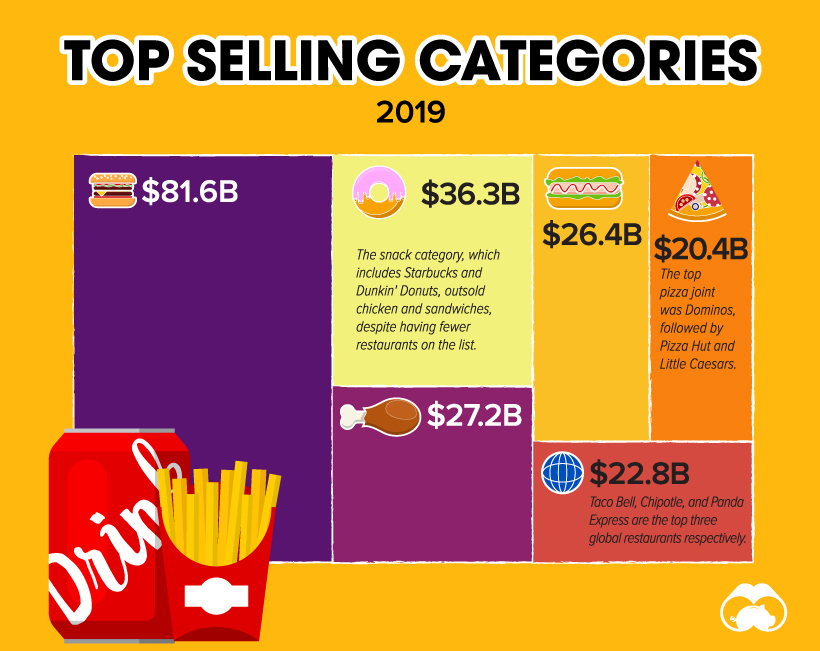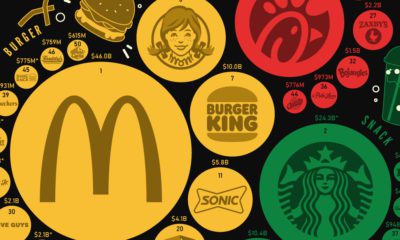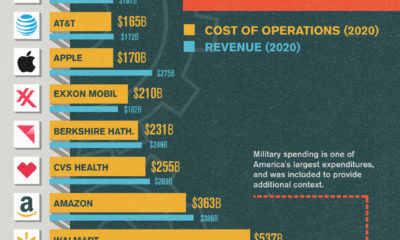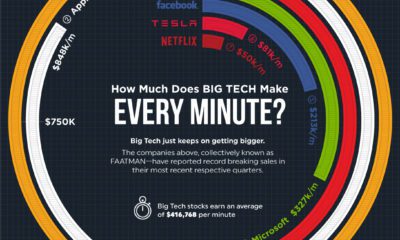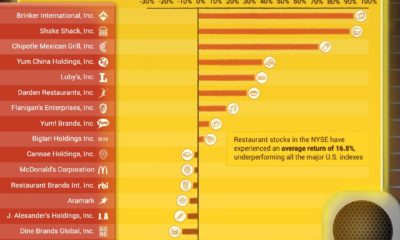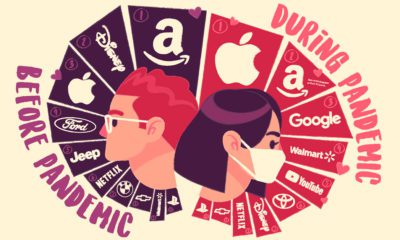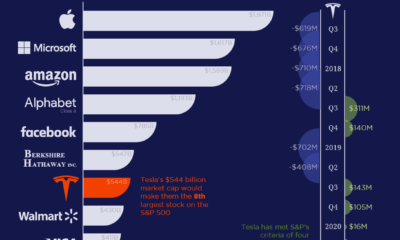From burgers to pad thai, there’s a quick service restaurant that’ll satisfy almost any appetite. With all this choice, which fast food chains are the most popular among consumers? Using data from QSR Magazine, today’s infographic ranks the top 50 largest fast food chains in the U.S. by sales in 2019, providing insight into the types of foods Americans have been craving.
Fast Food Chains Ranked, by Revenue
In 2019, the 50 largest fast food chains in the U.S. generated over $200 billion in revenue. How do these quick service giants stack up against each other? Unsurprisingly, McDonald’s comes in at number one with over $40 billion in sales. Despite a scandal involving its former CEO, McDonald’s still managed to significantly outsell its peers—the company made almost double that of the second-largest fast food chain, Starbucks. But don’t worry, Starbucks did just fine for itself. With $21 billion in sales, the Seattle-based coffee chain saw a 5% increase compared to its numbers in 2018.
Top Selling Fast Food Categories
Based on the ranking, it’s clear that Americans still love their McDonald’s. But are burgers, in general, the most popular fast food item? In short—yes. Burgers are king. Here’s a look at how burgers, pizza, chicken, and other food categories measure up:
Burger joints remain the most popular fast food option among consumers—14 of the 50 chains on the list are classified as burger restaurants, with $80 billion in collective sales. Snacks come in at second place, with a total of $36 billion in revenue. Boasting a broad variety of foods from iced coffee to donuts and ice cream, six of the restaurants on the list are included in this category. Starbucks is the most popular, followed by Dunkin’ and Dairy Queen respectively. While the chicken and sandwich categories both have nine restaurants included in the ranking, chicken restaurants outsold sandwiches by almost $1 billion. This is largely due to Chick-fil-A, which makes up more than a third of all chicken restaurant sales included in the ranking.
COVID Closures
It’s important to note that these numbers reflect the fast food industry before the devastating impacts of COVID-19. The global pandemic has forced many fast food restaurants to adapt, and it’s also triggered a number of restaurant shutdowns.
For instance, McDonald’s is set to permanently close 200 of its 14,000 U.S. locations, and Dunkin’ will be closing 450 restaurants by the end of 2020. Starbucks has also announced it’s planning to permanently shut down up to 400 locations by mid-2021.
With online sales more important than ever, the chains with a strong digital presence may be in a better position to weather the storm. Chains with physical distancing options, such as drive-throughs, could also recover quicker.
on
Even while political regimes across these countries have changed over time, they’ve largely followed a few different types of governance. Today, every country can ultimately be classified into just nine broad forms of government systems.
This map by Truman Du uses information from Wikipedia to map the government systems that rule the world today.
Countries By Type of Government
It’s important to note that this map charts government systems according to each country’s legal framework. Many countries have constitutions stating their de jure or legally recognized system of government, but their de facto or realized form of governance may be quite different. Here is a list of the stated government system of UN member states and observers as of January 2023: Let’s take a closer look at some of these systems.
Monarchies
Brought back into the spotlight after the death of Queen Elizabeth II of England in September 2022, this form of government has a single ruler. They carry titles from king and queen to sultan or emperor, and their government systems can be further divided into three modern types: constitutional, semi-constitutional, and absolute. A constitutional monarchy sees the monarch act as head of state within the parameters of a constitution, giving them little to no real power. For example, King Charles III is the head of 15 Commonwealth nations including Canada and Australia. However, each has their own head of government. On the other hand, a semi-constitutional monarchy lets the monarch or ruling royal family retain substantial political powers, as is the case in Jordan and Morocco. However, their monarchs still rule the country according to a democratic constitution and in concert with other institutions. Finally, an absolute monarchy is most like the monarchies of old, where the ruler has full power over governance, with modern examples including Saudi Arabia and Vatican City.
Republics
Unlike monarchies, the people hold the power in a republic government system, directly electing representatives to form government. Again, there are multiple types of modern republic governments: presidential, semi-presidential, and parliamentary. The presidential republic could be considered a direct progression from monarchies. This system has a strong and independent chief executive with extensive powers when it comes to domestic affairs and foreign policy. An example of this is the United States, where the President is both the head of state and the head of government. In a semi-presidential republic, the president is the head of state and has some executive powers that are independent of the legislature. However, the prime minister (or chancellor or equivalent title) is the head of government, responsible to the legislature along with the cabinet. Russia is a classic example of this type of government. The last type of republic system is parliamentary. In this system, the president is a figurehead, while the head of government holds real power and is validated by and accountable to the parliament. This type of system can be seen in Germany, Italy, and India and is akin to constitutional monarchies. It’s also important to point out that some parliamentary republic systems operate slightly differently. For example in South Africa, the president is both the head of state and government, but is elected directly by the legislature. This leaves them (and their ministries) potentially subject to parliamentary confidence.
One-Party State
Many of the systems above involve multiple political parties vying to rule and govern their respective countries. In a one-party state, also called a single-party state or single-party system, only one political party has the right to form government. All other political parties are either outlawed or only allowed limited participation in elections. In this system, a country’s head of state and head of government can be executive or ceremonial but political power is constitutionally linked to a single political movement. China is the most well-known example of this government system, with the General Secretary of the Communist Party of China ruling as the de facto leader since 1989.
Provisional
The final form of government is a provisional government formed as an interim or transitional government. In this system, an emergency governmental body is created to manage political transitions after the collapse of a government, or when a new state is formed. Often these evolve into fully constitutionalized systems, but sometimes they hold power for longer than expected. Some examples of countries that are considered provisional include Libya, Burkina Faso, and Chad.
